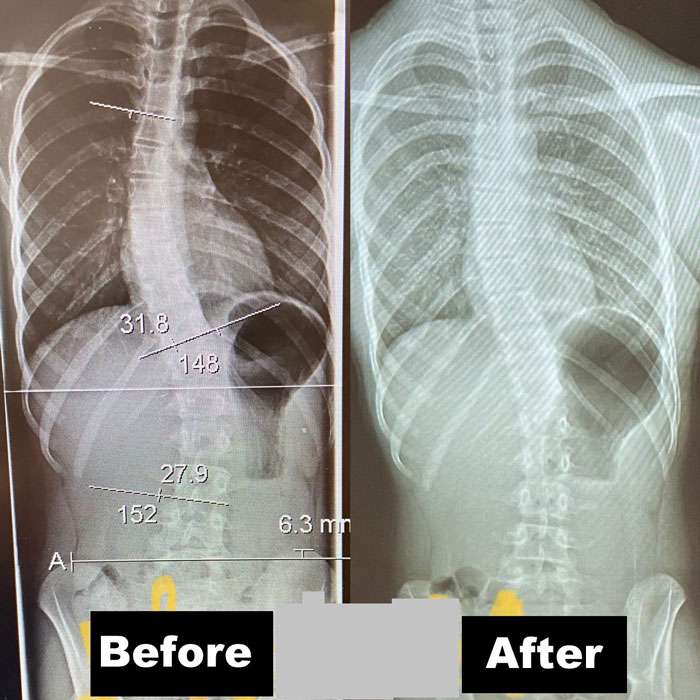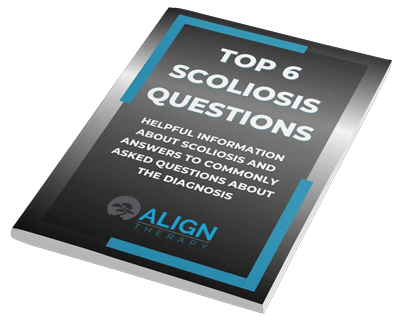Yesterday, while treating a patient with scoliosis at my clinic in Lehi Utah, I was asked an interesting question. I get questions all the time about scoliosis and most of the time they are very similar.
“Jimmy always sits in weird positions while doing his homework. I keep telling him to sit up straight but he doesn’t listen. Can you tell him that is what caused his scoliosis?”

Now, posture does play a role in the progression of scoliosis, which is why treatment involves The Schroth Method to reduce the scoliosis posture. But…it is not what caused it. Technically we call most scoliosis “Idiopathic”, meaning “of unknown cause”, but we are learning more that there is a genetic component to it.
So, that is one myth I hear on a consistent basis. There are many myths surrounding scoliosis. Some of them, unfortunately, steer people away from getting the treatment they need, and we try to dispel those. Others are just interesting and thought provoking.
Alright, lets talk about the top 5 myths I hear about scoliosis.
1. Scoliosis is caused by poor posture.
Yes, we already discussed this, but I think it is worth spelling it out a little more specifically. The cause of scoliosis, most of the time, is idiopathic and we don’t know the specific cause.
Most of my patients have a close family member with scoliosis, indicating a genetic cause. Others have no family history. It is interesting that we still don’t know the cause of most scoliosis cases, but research is getting closer to figuring this out.
There are many other causes of scoliosis. Neurological scoliosis can happen when the neurological system is compromised in some way. Spina bifida, cerebral palsy, and Chiari malformations are all examples of this.
Congenital Scoliosis is caused by something from birth. This is usually a misshapen vertebra and causes the spine to curve. Obviously, this is completely out of our control.
Posture, on the other hand, does not cause scoliosis. It can, and does, cause many other issues like headaches, neck pain, shoulder impingement, low back pain, etc…but not scoliosis.
2. If you have scoliosis, you must wear a brace or have surgery.
Scoliosis comes in many shapes and sizes. Not all scoliosis is the same, and not all curves can be braced or are appropriate for surgery. The fact is most scoliosis is mild and doesn’t need significant treatment. Most of the scoliosis cases won’t progress to needing a brace, and even fewer will progress to needing surgery.
But…some do. If we think about the ratings for scoliosis, it might give you a better idea.
Curves under 10 degrees aren’t even classified as scoliosis. It could be due to standing different or posture. At this size, it is not certain that it is scoliosis.
Curves from 10-24 degrees are called “Mild” curves. These are the ones that we do scoliosis specific exercise and posture training with. We do this to prevent them from progressing and needing further intervention.

Curves from 25-45 degrees are “Moderate” curves. These are the ones that are braced if the patient is still growing. The brace helps to reduce progression of the curve by providing a force counter to the scoliosis. This is also where we double our efforts on scoliosis specific exercise to avoid progression.

Curves 45 degrees and above are surgical candidates. This is done because these curves have the tendency to increase even after growth is done.
As you see, until you get to 25 degrees, you don’t need a brace in most cases, and definitely don’t need surgery. Obviously, this varies on a case by case basis.
Now, this doesn’t mean we use the old school “wait and see” approach where we wait and see if things get worse…without doing anything. Doing something, such as the Schroth Method, is ALWAYS better than doing nothing and seeing if it gets worse. Obviously, it HAS gotten worse, so why wait until it gets MORE worse?
3. You should avoid impact activities if you have scoliosis.
This is one I hear a lot. Back 15-20 years, the suggestion for most scoliosis patients was to swim because it was “less impact on the spine”. It was thought this would reduce the curve progressing and they would have less back pain.
In hindsight, this was not good advice…for a few reasons.
First, impact and resistance are how our bones gain density. Since scoliosis is a “bone deformity”, we want more bone density and health. Also, these are the years where we are banking bone for the future. Limiting impact makes the bones less strong and healthy.
Second, swimming increases rotation. Recently, there was a study out of Italy by ISICO that showed an increase in rotation in patients with scoliosis when their exercise was swimming. It did not show their Cobb angle was any different than other patients who did regular activities.
Third, I don’t want to restrict these kids from doing what they enjoy. I feel it is more important for kids and teens to be active, than restrict them from doing things that we have very little evidence against.
The conclusion…be active!
4. Scoliosis can be “fixed” with spinal manipulation or other treatments.
Occasionally I will have someone come into the clinic where they had been seen by a practitioner who claimed to be able to “fix” their scoliosis. I am always VERY cautious of those claims.
First, scoliosis is a bone deformity, which means the bones are shaped differently. Because of this, unless you can go in and change the shape of the bones, you can’t “fix” the problem.
Now, with that said, there is a surgical intervention called VBT that can significantly improve the shape of the bones, but this requires surgery and doesn’t completely “fix” the spine.
Once you have scoliosis, you will always have scoliosis. Anyone claiming to be able to “fix” it……well, you get the idea.
Scoliosis specific exercise, like the Schroth Method, doesn’t claim to “fix” the curve, but improve the curve or stops it from progressing. This improvement happens with a lot of work and is not a quick thing.
5. Exercise doesn’t change the scoliosis curve.
Well, this is a tricky one. I truly believe that exercise helps to keep our bodies, bones, and backs healthy and should be used with spinal deformities, but….no, general exercise doesn’t influence the curve.
Now, there is a big difference between general exercise, or even general physical therapy, and Physiotherapeutic Scoliosis Specific Exercise (PSSE). The difference is in how it is directed and the understanding of the spine.
In 2016 there was an article that showed no change in the Cobb angle (the angle measuring scoliosis) with general physical therapy intervention. However, when treatment was done with someone trained in PSSE, there was a significant change in the curve.
For a long time, physical therapists have viewed scoliosis as a problem where you stretch the concave side and strengthen the convex side. The problem is that this is an incorrect and WAY to simplistic way of looking at scoliosis.
Scoliosis is a 3-dimensional deformity, and this view is only looking at one dimension. We still have rotation and general posture to look at. And the truth of it is that both sides of the spine are weak, for different reasons, and tight, for different reasons.
Just like any treatment, the more specialized you get, the better the results. That is why when you have a heart attack, you go to see a cardiologist…because he knows more about the heart and can get better outcomes. The same goes for scoliosis and conservative treatment.
There you have it, 5 myths about scoliosis and the explanations of why they are FALSE. There are many more myths surrounding scoliosis and other spinal deformities, but these are the most common ones I see.
In treating scoliosis with the Schroth Method and SEAS approach for the last 7 years, I have learned there is no “one size fits all” approach to scoliosis. But, dispelling the myths surrounding this diagnosis, and getting people the best treatment available is our goal.
We get amazing outcomes with scoliosis treatment. If you, or someone you love, is struggling with scoliosis, please don’t hesitate to contact my clinic. We are here to help you dispel myths while avoiding pain, bracing, and surgery.
Thanks for reading!
David Butler, DPT



